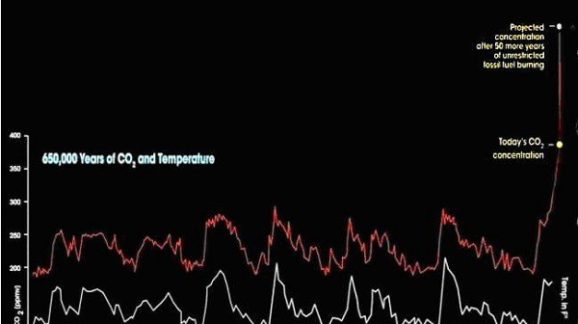Study Finds Non-Greenhouse Role for CO2 in Ice Age Cycles

Ellis and Palmer (2016), a study recently published in Geoscience Frontiers, sheds new light on the role of atmospheric carbon dioxide (CO2) in the alternation between glacial and interglacial periods.
In An Inconvenient Truth (AIT), Al Gore displayed a graph, based on Antarctic ice core data, plotting CO2 levels and global temperatures going back 650,000 years. He commented:
“It’s a complicated relationship but the most important part of it is this: When there is more CO2 in the atmosphere, the temperature increases because more heat from the Sun is trapped inside.”

Gore chose his words carefully. He did not actually say that changes in CO2 levels cause ice age cycles, but he allowed or even encouraged viewers to draw that conclusion. In reality, warm interglacial periods typically precede increases in CO2 levels by 600 ± 400 years.
The causality is nearly the opposite of what Gore insinuated. When ocean temperatures fall, seawater retains more dissolved CO2, and the expansion of polar sea ice further limits sea-to-air CO2 flux. Conversely, when the oceans warm, more dissolved CO2 outgases into the air. The science on these matters was well known when Gore developed the slide show presentation that became AIT.
However, some of Gores allies, such as the bloggers at Skeptical Science (SS), argue that rising CO2 levels had an important amplificatory effect on any warming trend already under way: “This positive feedback is necessary to trigger the shifts between glacials and interglacials as the effect of orbital changes is too weak to cause such variation.”
Ellis and Palmer agree with SS that orbital changes alone do not fully account for the shift from glacials to interglacials, but they take a very different view of the role of CO2. Some quick background here may be useful.
There are three types of orbital mechanics affecting global climate. Known as Milankovitch Cycles, they include precession (rotational motion of the Earth’s axis), eccentricity (deviations in Earth’s orbit from a perfect circle), and obliquity (angle between the Earth’s rotational and orbital axes). All change solar insolation in the Northern hemisphere during the summer months—that is, the amount of radiant solar energy received, measured in watts per square meter (W/M2).
The cycles have separate timescales (precession: 15,000-27,000 years; eccentricity: 90,000-100,000 years; obliquity: 41,000 years). Even when the cycles align to produce maximum insolation, they may not be enough to end an “ice age” (glaciation). A 100,000-year ice age cycle may have four or five solar maxima but only one interglacial.

What other factor or factors must be present to produce interglacial warmth? That is the mystery Ellis and Palmer set out to solve. In their words:
“Since the discovery of ice-age cycles almost two centuries ago, a large amount of geological evidence has been assembled from a variety of sources, and many different hypotheses have been advanced to account for their approximate 100 kyr periodicity and asymmetric, saw-tooth temperature response. Improved calculations of Milankovitch insolation cycles and greater precision of Antarctic ice-core records demonstrate that each major deglaciation coincides with maximum summer insolation in the northern hemisphere. And yet many of the other insolation maxima only trigger minor warming events, and so interglacials only occur after four or five insolation cycles. No generally accepted explanation exists for this peculiar intermittent climate response, and any comprehensive explanation for ice-age modulation and periodicity has to be able to explain this anomaly.”
Their answer, elegant in its economy and simplicity, is also quite paradoxical. Carbon dioxide plays a critical role but not, as Gore and SS contend, because CO2 is a greenhouse gas. Rather, CO2 is a climate driver because it is plant food.
The causality works like this. Global cooling depresses atmospheric CO2 levels down to 190-200 parts per million—barely enough to sustain plant life. Inadequate CO2 wipes out forests and grasslands, especially in high altitude areas with cold climates. Vegetation dieback increases soil erosion, drying, and desertification. Those changes in soils increase dust storms. Dust deposited on ice sheets over millennia significantly reduce their albedo (ability to reflect rather than absorb sunlight). Reduced albedo enables the next solar maxima to melt the ice, shifting the climate into an interglacial.
The empirical basis for this theory is intuitively compelling.
First, over geologic time (the past 800,000 years), millennia of declining CO2 levels always precede periods of increased dust storms.
Second, millennia of increased dust storms always precede interglacial periods.
The researchers summarize their argument as follows:
“Ice ages are therefore forced by orbital cycles and Milankovitch insolation, but regulated by ice albedo and dust-albedo feedbacks. And the warming effects of dust-ice albedo are counterintuitively caused by a reduction in global temperatures and a corresponding reduction in CO2 concentrations. And while this proposal represents a reversal of conventional thinking it does explain each and every facet of the glacial cycle, and all of the many underlying mechanisms that control its periodicity and temperature excursions and limitations.”
The study concludes by noting that although CO2 plays a key role in regulating global climate on geologic time scales, “the greenhouse-gas attributes of CO2 play little or no part in this complex feedback system.”